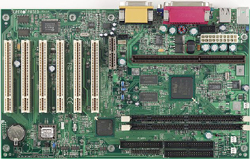Supermicro PIIISED ATX Slot-1 i810E
by Elliott Lee Hazen on January 23, 2000 2:33 PM EST- Posted in
- Motherboards
Supermicro has been around since 1992 and has continually produced, solid boards ideal for workstations. Even though Supermicro has focused on high end systems, they have recently begun to enter the low end market. This marketing strategy began with the socket 370 i810 370SWD and now the PIIISED.
Intel's new i810E chipset is a perfect candidate to be included on a motherboard designed for a quality, low-priced machine. It is identical to the i810 with the added 133MHz FSB speed. However, because the main advantage of the chipset is the low price due to onboard video and audio, quality construction might be compromised. Even though it might seem an odd combination to have a high end CPU with a low end chipset, this was the only solution Intel had while the i820 was delayed. Read on to see if the most recent addition to the AnandTech lab, the PIIISED is up to the usual Supermicro standards.
New Anand Tech Report Card Rating 88/B+
| CPU Interface |
Slot-1
|
| Chipset |
Intel
810E
|
|
On-Board
Video
|
82810E
GMCH
|
| I/O Controller |
82801
ICH
|
| L2 Cache |
N/A (on-chip)
|
| Form Factor |
ATX
|
| Bus Speeds |
66
/ 72 / 75 / 83 |
| Clock Multipliers |
2.5x - 6.0x
|
| Voltages Supported |
Autodetect
|
| Memory Slots |
2 168pin DIMM Slots
|
| Expansion Slots |
1 AMR Slots
0 AGP Slot 6 PCI Slots (5 Full Length) 0 ISA Slots |
| BIOS |
AMI BIOS HiFlex 1.18
|
The Good
At first glance, the Supermicro's i810E board is pretty standard for a Slot-1 CPU, except for the noticeably shortened depth of 7 inches. The PIIISED is equipped with a 6/1/0 (PCI/AMR/AGP) expansion slot configuration. The board sports two DIMM slots, the maximum allowed by the i810E chipset. Other than the optional wake on LAN header, nothing blocks the PCI slots allowing up to five full length cards.
The layout of the PIIISED follows the ATX specification and almost all of the components were placed to minimize cable clutter. All hard drive and floppy connectors are optimally located at the front of the board, so that no cables are forced to run over either the CPU or the memory. However, the ATX power connector is placed at the back of the board, behind the CPU slot. Running the power cable over the memory and CPU leads to more clutter and reduces airflow through the case. While this is not a dire problem, it would be nice to see optimal design embraced, making the lives of computer technicians easier. To be PC99 compliant, the standard colored connectors are included on the backpanel.
While the i810 provided options in choosing the GMCH (Graphics and Memory Controller Hub) as well as the ICH (I/O Controller Hub), all i810E boards will sport the 82810E GMCH and the 82801 ICH. The 82801 ICH allows full Ultra DMA/66 support as do i810 boards but the 82810E GMCH has 4MB of display cache which runs at 133MHz -- another added advantage of the i810E over the i810. The two 2MB Hyundai SDRAM chips are rated at 7ns or 143MHz, plenty for the 133MHz i810E and gives some leeway in overclocking situations. Since the GMCH runs rather cool, Supermicro opted not to place a heatsink atop the chip. The advantage of the i810E with on-board video and sound can also be a disadvantage for users that desire peak graphical performance or maximum CPU power. The included AC97 CODEC is sufficient for basic audio but it utilizes the CPU for processing power. If needed, the CODEC can be disabled by a jumper allowing the addition of a PCI soundcard preserving CPU power and a PCI video card can be substituted for the integrated video.











0 Comments
View All Comments